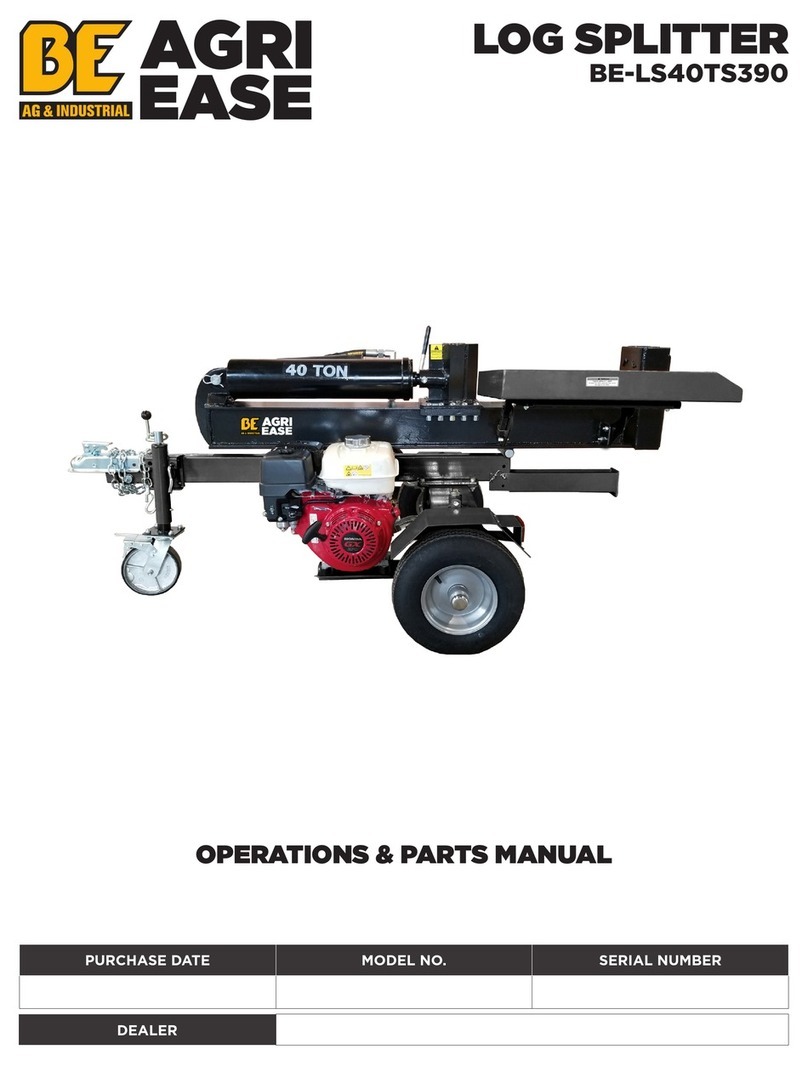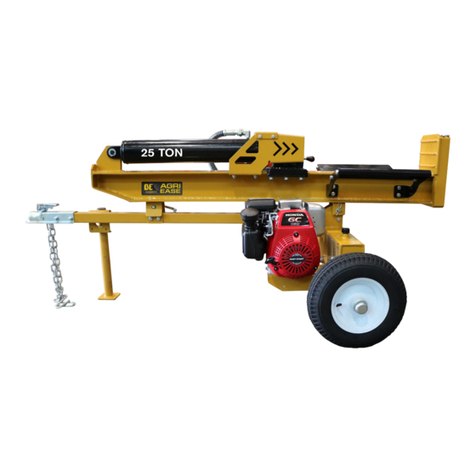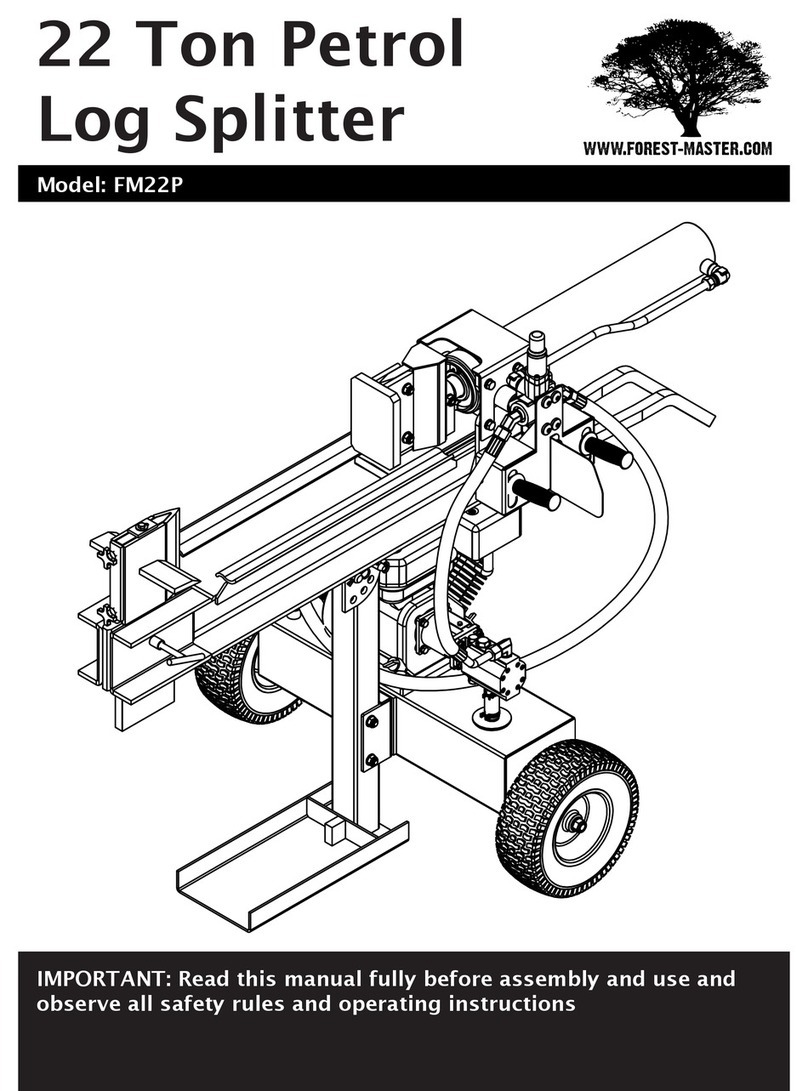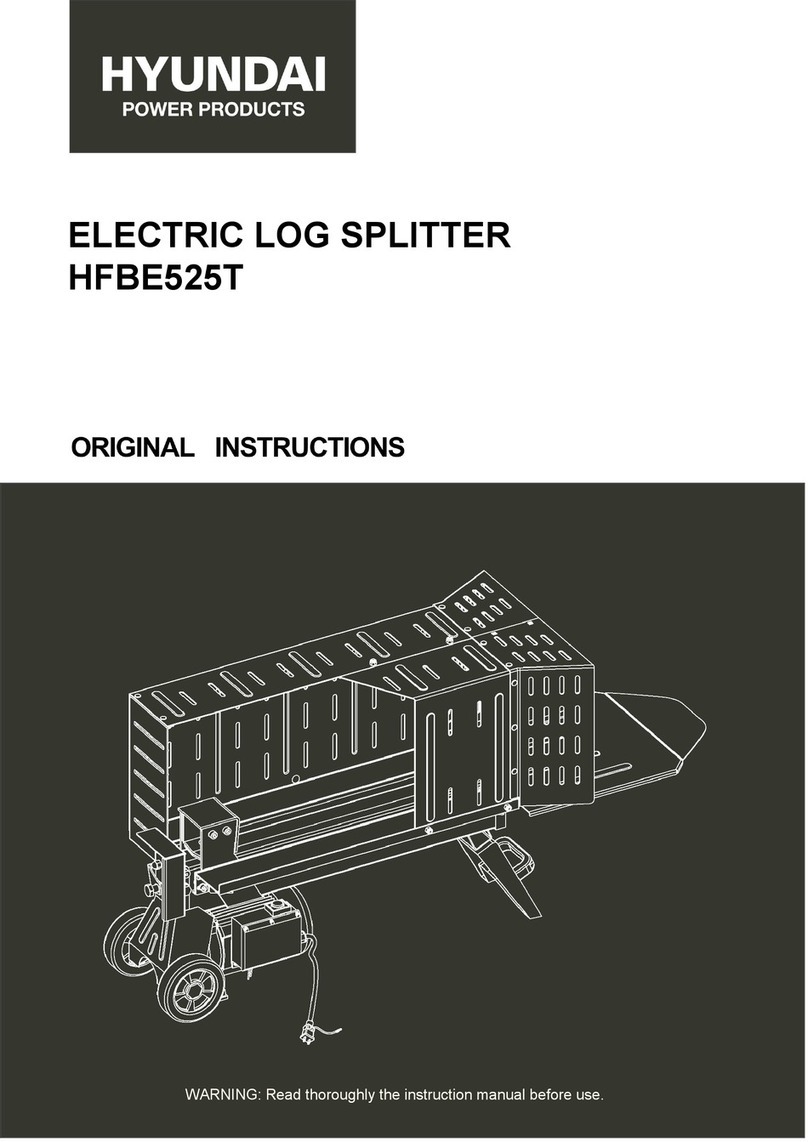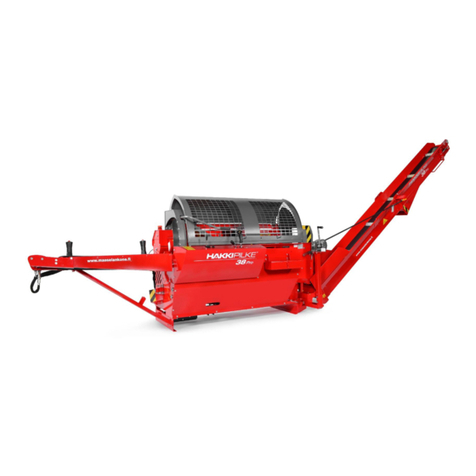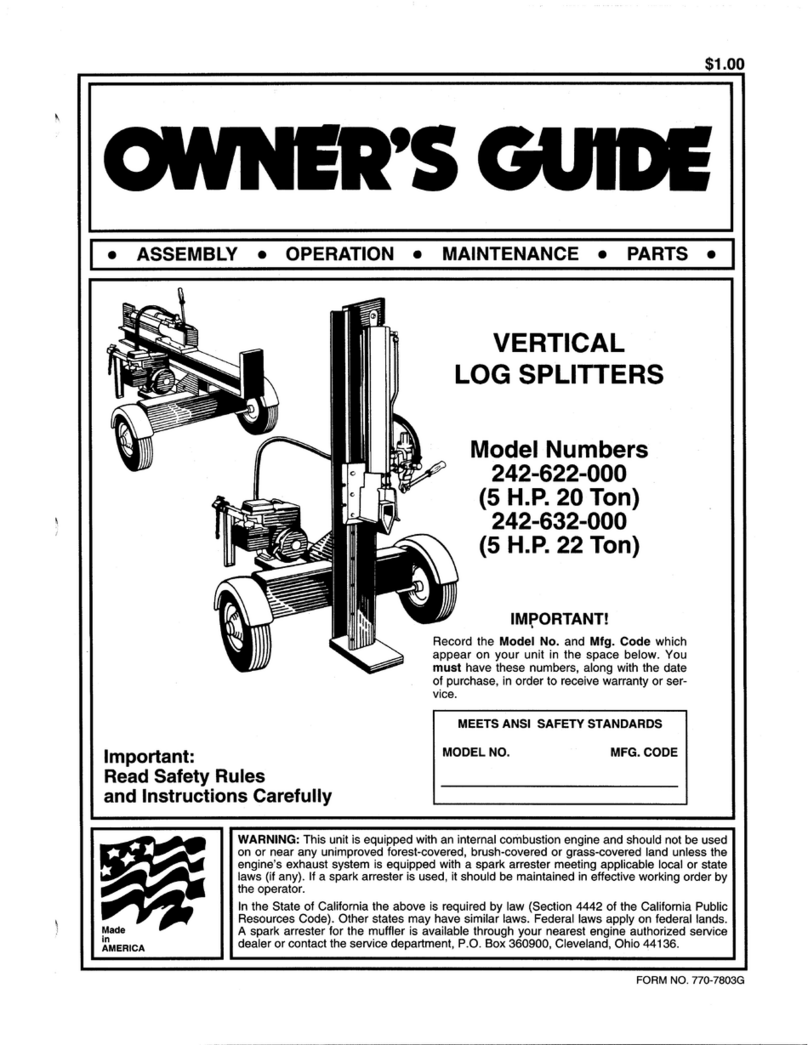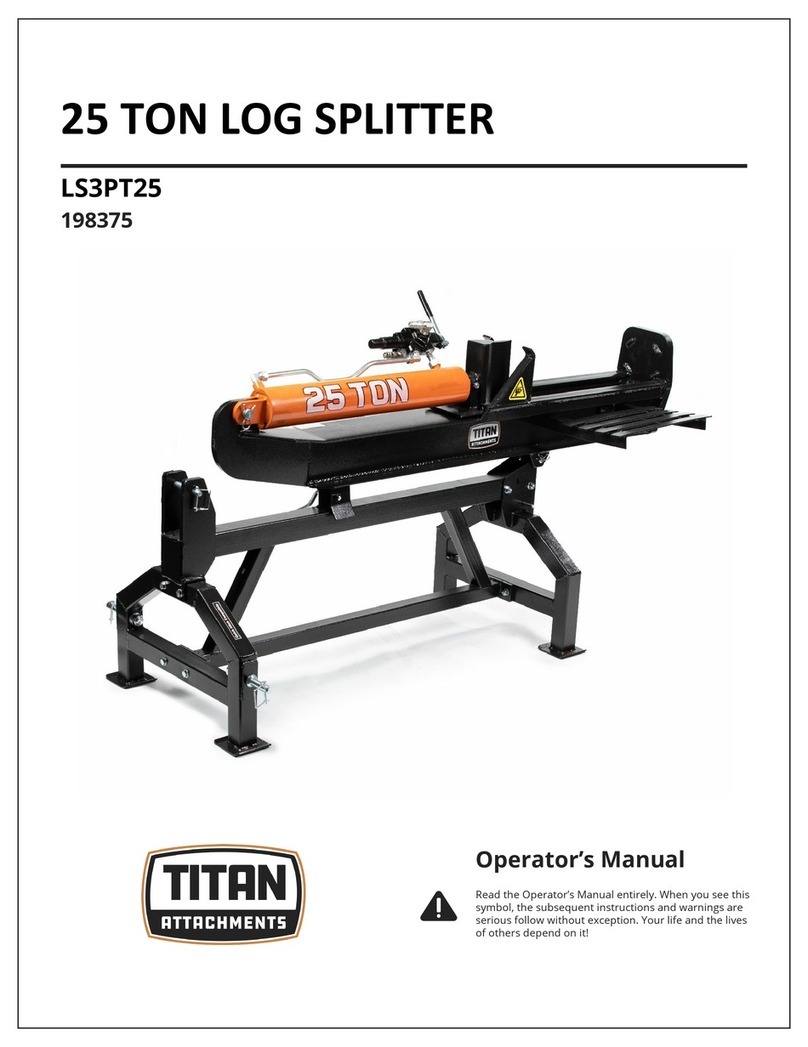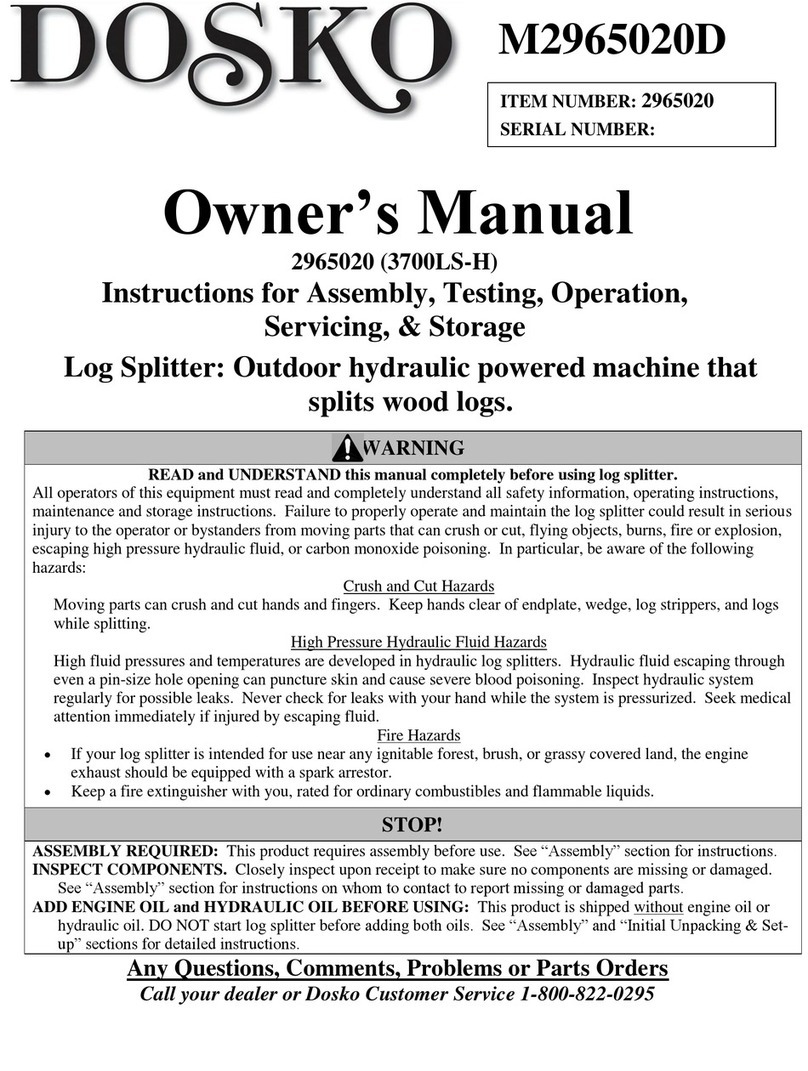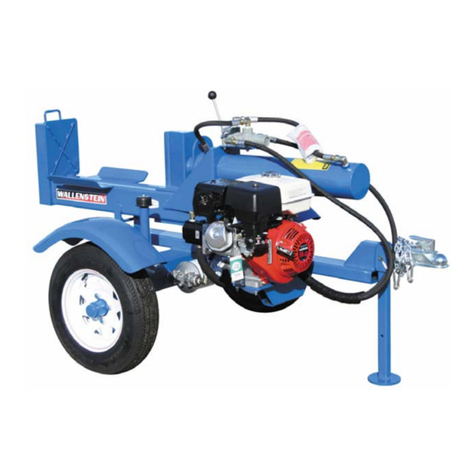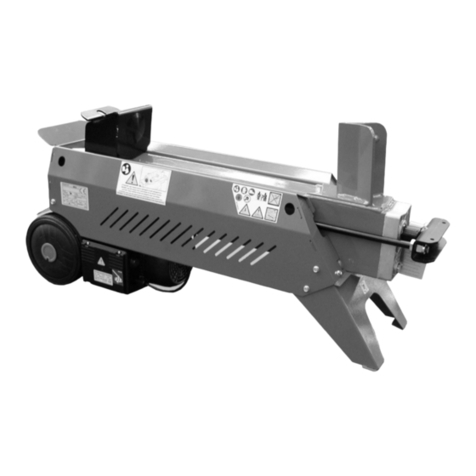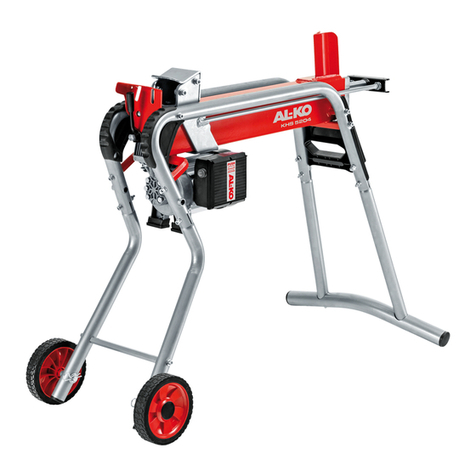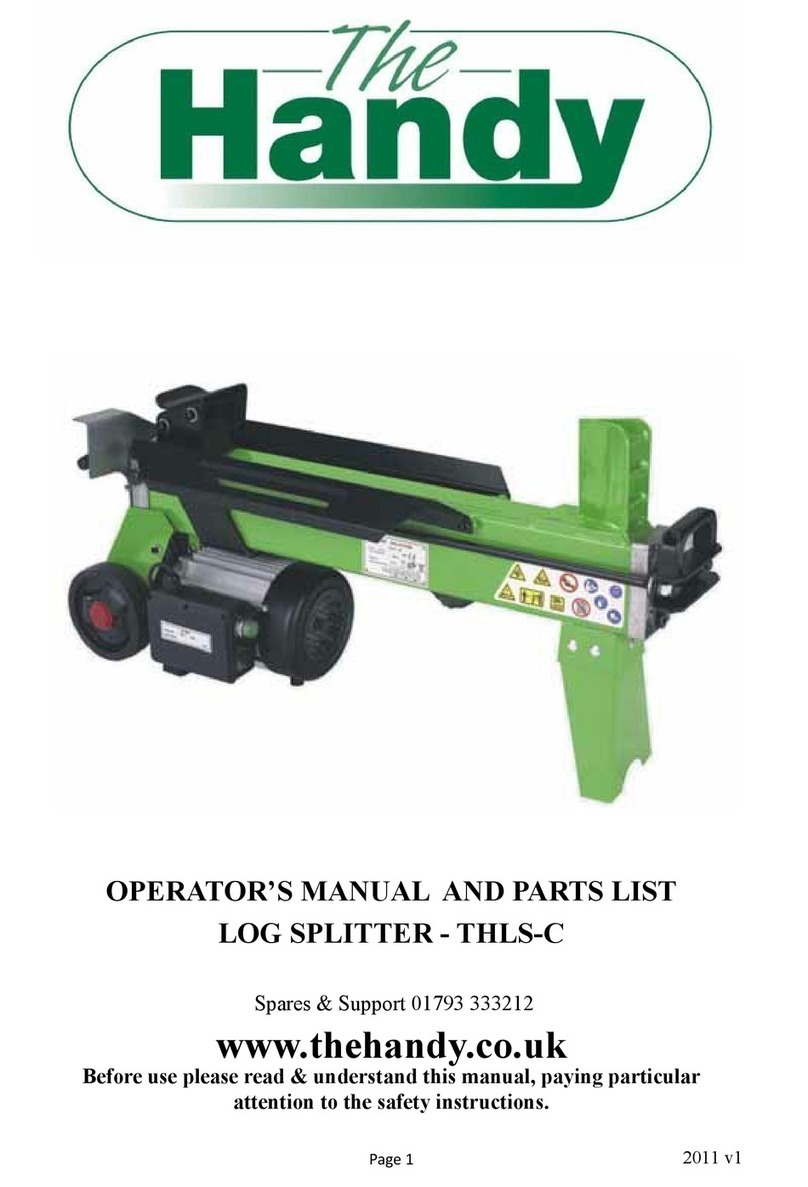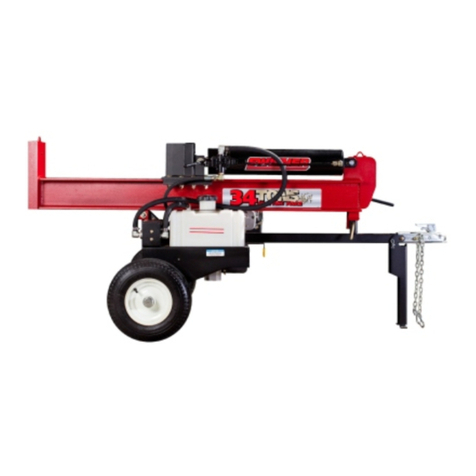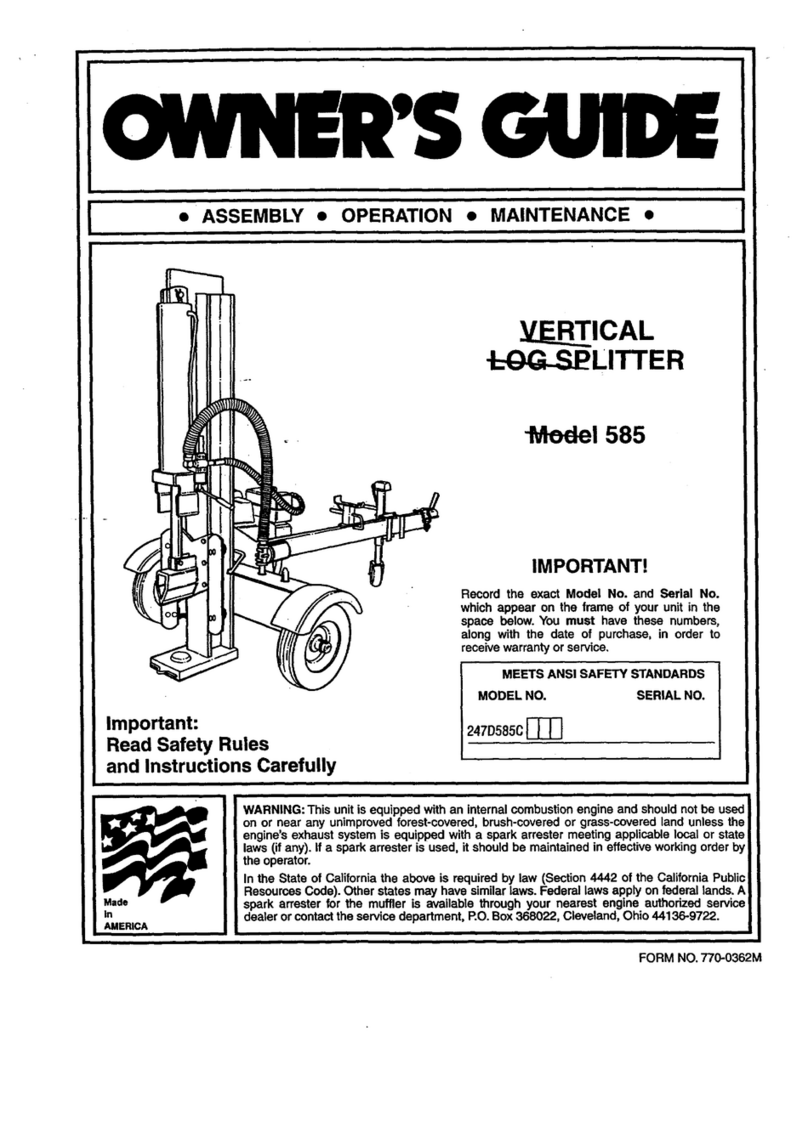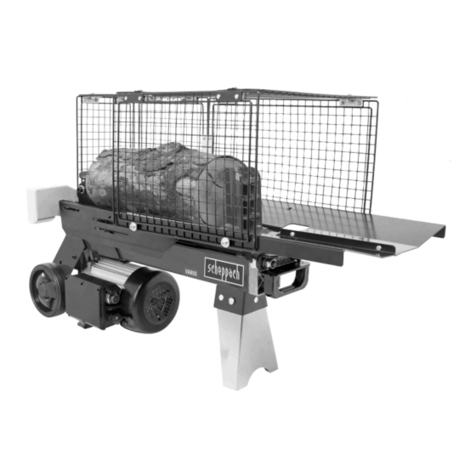BE Ag & Industrial AGRI EASE BE-LS22TL65070 User manual

HORIZONTAL / VERTICAL
22 / 28 / 34 TON
GAS LOG SPLITTER
Owner’s Manual
ASSEMBLY & OPERATING INSTRUCTIONS
Purchase Date__________Model NO. ________ _ Serial NO._________________
Dealer___________________________________ _____________________
MODEL NO.
BE-LS22TL65070, BE-LS22TL6505GC, BE-LS22TL65065GX
BE-LS28TL6506GC, BE-LS28TL65065GX, BE-LS34TL6509GX


To The Owner
Thank You!
Thank you for purchasing our Log Splitter. It was carefully engineered to provide excellent performance when properly
operated and maintained.
Please read this entire manual prior to operating the equipment. It instructs you how to safely and easily set up, operate
and maintain your machine. Please be sure that you, and any other persons who will operate the machine, carefully follow
the recommended safety practices at all times. Failure to do so could result in personal injury or property damage.
All information in this manual is relative to the most recent product information available at the time of printing. Review
this manual frequently to familiarize yourself with the machine, its features and operation. Please be aware that this
Operator’s Manual may cover a range of product specifications for various models. Characteristics and features discussed
and/or illustrated in this manual may not be applicable to all models. We reserve the right to change product specifications,
designs and equipment without notice and without incurring obligation.
If applicable, the power testing information used to establish the power rating of the engine equipped on this machine can
be found at the engine manufacturer’s web site. If you have any problems or questions concerning the machine, phone an
authorized service dealer. We want to ensure your complete satisfaction at all times.
Throughout this manual, all references to right and left side of the machine are observed from the operating position
The engine manufacturer is responsible for all engine-related issues with regards to performance, power-rating,
specifications, warranty and service. Please refer to the engine manufacturer’s Owner’s/Operator’s Manual, packed
separately with your machine, for more information.

Table of Contents
Page(s)
Important Safety Information................................................................................................................. 1-10
General Safety Alert Signals ................................................................................................... 1
Safety Decals ........................................................................................................................... 2
Safety Symbols ........................................................................................................................ 3
Training .................................................................................................................................... 4
Preoperation ............................................................................................................................... 5
Operation ................................................................................................................................... 6
Operator Zone ........................................................................................................................... 7
Maintenance Safety ................................................................................................................... 8
Fire Prevention ........................................................................................................................... 9
Towing Safety ............................................................................................................................. 10
Assembly & Set-up Instructions ............................................................................................................... 11-23
Unpacking the Container.............................................................................................................. 11-12
Assembling ................................................................................................................................. 13-20
Set-up .......................................................................................................................................... 21-22
Know Controls & Features............................................................................................................ 23
Operating Instructions ............................................................................................................................... 24-28
Starting & Stopping the engine ..................................................................................................... 24
Operating Positions ...................................................................................................................... 24
Using Control handle .................................................................................................................... 25
Splitting the Wood ......................................................................................................................... 26
Operation Tips ............................................................................................................................... 27
Transporting the Log Splitter ......................................................................................................... 28
Maintenance & Adjustments........................................................................................................................ 29-30
Troubleshooting........................................................................................................................................... 31
Specifications ............................................................................................................................................. 32
Exploded Diagram & Parts List .................................................................................................................. 33-35
Packing List ............................................................................................................................................... 36

WARNING: Read and thoroughly understand all instructions in this manual and on safety decals before
assembling or operating this log splitter. Failure to do so may cause serious injury or death. Do not
allow anyone to operate this log splitter who has not read this manual. As with all power equipment, a
log splitter can be dangerous if assembled or used improperly. Do not operate this log splitter if you
have any questions concerning safe operation. To get answers to any questions, call authorized
customer service dealer.
Si no entiende ingles, se prefiere que busque alguien que interprete las instrucciones para usted.
This SAFETY ALERT SYMBOL identifies important safety messages in this manual.
Failure to follow this important safety information may result in serious injury or death.
CALIFORNIA PROPOSITION 65
WARNING! Engine Exhaust, some of its constituents, and certain vehicle components
contain or emit chemicals known to State of California to cause cancer and birth defects
or other reproductive harm.
DANGER! This machine was built to be operated according to the safe operation practices in this
manual. As with any type of power equipment, carelessness or error on the part of the operator can
result in serious injury. This machine is capable of amputating hands and feet and throwing debris.
Failure to observe the following safety instructions could result in serious injury or death.
The following signal words and meanings are intended to explain the levels of risk associated with this product.
DANGER indicates a hazardous situation which, if not avoided,
will result in serious injury or death.
WARNING indicates a hazardous situation which, if not avoided,
could result in serious injury or death.
CAUTION indicates a hazardous situation which, if not avoided,
could result in minor or moderate injury.
NOTICE is used to address practices not related to personal
injury.
Page 1

Page 2
Make sure that all safety warning decals are in good condition and readable. Always replace missing or defaced decals.
Contact the Authorized Service Dealer for replacement decals.
SAFETY DECALS

This page depicts and describes safety symbols that may appear on this product. Read, understand, and follow all
instructions on the machine before attempting to assemble and operate.
READ THE OPERATOR’S MANUAL(S)
Read, understand, and follow all instructions in the manual(s) before attempting to
assemble and operate.
FACE PROTECTION
Always wear safety goggles or safety glasses with side shields, earplugs and a face shield
when operating this product.
WARNING— MOVING WEDGE
Keep hands away from wedge, moving part, end plate, and partially split wood.
BYSTANDERS
Keep bystanders, helpers and children at least 25 feet away.
SINGLE OPERATOR
Only one person should operate the machine at a time. The adult who loads and stabilizes
the log must be the person who operates control handle.
WARNING— PRESSURIZED FLUID
Never check for hose leaks with your hands. High pressure fluid can escape through a pin
hole leak and cause serious injury by puncturing the skin and causing blood poisoning.
WEAR GLOVES
Always wear nonslip, heavy-duty protective gloves when operating this product.
WEAR SAFETY FOOTWEAR
Always wear nonslip steel-toed safety footwear when operating this product.
WARNING—GASOLINE IS FLAMMABLE
Allow the engine to cool at least ten minutes before refueling.
WARNING— CARBON MONOXIDE
Never run an engine indoors or in a poorly ventilated area. Engine exhaust contains carbon
monoxide, an odorless and deadly gas.
WARNING— HOT SURFACE
Engine parts, especially the muffler, become extremely hot during operation. Allow engine
and muffler to cool before touching.
SAFETY SYMBOLS
Symbol Description
WARNING! Your Responsibility—Restrict the use of this power machine to persons who read,
understand and follow the warnings and instructions in this manual and on the machine.
SAVE THESE INSTRUCTIONS!
Page 3

TRAINING
1. Read, understand, and follow all instructions on the machine and in the manual(s) before attempting to assemble and
operate. Keep this manual in a safe place for future and regular reference and for ordering replacement parts.
2. Be familiar with all controls and their proper operation. Know how to stop the machine and disengage them quickly.
3. Never allow children under 18 years of age to operate this machine. Children 16 and over should read and
understand the instructions and safe operation practices in this manual and on the machine and be trained and
supervised by an adult.
4. Never allow adults to operate this machine without proper instruction.
5. Many accidents occur when more than one person operates the machine. No helper is allowed to assist in stacking
logs.
6. Keep bystanders, pets, and children at least 25 feet from the machine while it is in operation.
7. Never allow anyone to ride on this machine.
8. Never transport cargo on this machine.
9. Hydraulic log splitters develop high fluid pressures during operation. Fluid escaping through a pin hole opening can
penetrate your skin and cause blood poisoning, gangrene, or death. Give attention to the following instructions at all
times:
a. Do not check for leaks with your hand.
b. Do not operate machine with frayed, kinked, cracked, or damaged hoses, fittings, or tubing.
c. Stop the engine and relieve hydraulic system pressure by cycling the valve control lever from forward to reverse
several times while engine is not running; returning to neutral before repairing or adjusting fittings, hoses, tubing, or
other system components.
d. Do not adjust the pressure settings of the pump or valve.
10. Leaks can be detected by passing cardboard or wood, while wearing protective gloves and safety glasses, over the
suspected area. Look for discoloration of cardboard or wood.
11. If injured by escaping fluid, see a doctor immediately. Serious infection or reaction can develop if proper medical
treatment is not administered immediately.
12. Keep the operator zone and adjacent area clear for safe, secure footing.
13. If your machine is equipped with an internal combustion engine and is intended for use near any unimproved forest,
brush, or grass covered land, the engine exhaust should be equipped with a spark arrestor. Make sure you comply
with applicable local, state, and federal codes. Take appropriate firefighting equipment with you.
NEVER use this log splitter for any purpose other than
splitting wood. It is designed for this use only. Any other
use can cause serious injury or death.
Page 4

Page 3
1. BEFORE operating this log splitter, make sure that you wear safety gear such as goggles or safety glasses,
steel toed shoes and tight fitting gloves (without loose cuffs or draw strings). Always wear a protective hearing
device when operating this log splitter.
2. NEVER wear loose clothing or jewelry that can be caught by moving parts of the log splitter. Keep clothing and
hair away from all moving parts when operating this log splitter.
3. Check all safety guards and shields to be sure they are in the proper position. Never operate with safety guards,
shields, or other protective features removed.
4. Make sure machine is on a flat, dry, solid ground before operating.
5. ALWAYS operate your log splitter in an open area. (Exhaust fumes contain carbon monoxide which can be
deadly when inhaled.)
6. ALWAYS operate your log splitter in daylight or under good artificial light.
7. ALWAYS operate your log splitter on level ground. (Operating on a slope could cause the log splitter to roll over
or logs to fall off.)
8. ALWAYS block wheels to prevent unintended movement.
9. ALWAYS lock beam in either the horizontal or vertical position.
10. ALWAYS keep the work area clean. Remove split wood around the log splitter immediately so that you don’t
stumble over it.
11. Check all nuts, bolts and hydraulic fittings are tight to be sure the equipment is in a safe working condition.
12. Both ends of the log should be cut as square as possible to help prevent the log from riding out of the splitter
during operation. Do not split logs greater than 25 inches in length. Uneven logs (e.g. knotted, curved, etc.)
should not be used.
13. ALWAYS check the oil level before you start the log splitter. See Page 30.
14. Do not allow familiarity with tools to make you careless. Remember that a careless fraction of a second is
sufficient to inflict serious injury.
WARNING:
The operation of any power tool can result in foreign objects being thrown into your eyes, which
can result in
severe eye
damage. Before beginning power tool operation, always wear safety goggles
or s
a
f
e
t
y glasses with side shields and, when needed, wear a full face shield and earplugs. We
recommend a Wide Vision Safety Mask for use over
eyeglasses
or standard safety glasses with side
shields. Always use eye protection which is marked to comply with ANSI Z87.1.
INTENDED USE
PREOPERATION
Page 5

OPERATION
1. BEFORE starting this machine, review the safe instructions in the manual. Failure to follow these rules may result in
serious injury to the operator or bystanders.
2. NEVER leave this machine unattended with the engine running.
3. DO NOT operate machine while under the influence of alcohol, drugs, or medication.
4. NEVER allow anyone to operate this machine without proper instruction.
5. ALWAYS operate this machine with all safety equipment in place and working. Make sure all controls are operating
properly for safe operation.
6. When loading a log, always place your hands on the side of the log, not on the ends, and never use your foot to help
stabilize a log. Failure to do so, may result in crushed or amputated fingers, toes, hand, or foot.
7. NEVER use your foot, a rope or any extension device to operate the control lever on the valve. Only use hand.
8. Use only your right hand to operate the controls.
WARNING! When stabilizing log with left hand, remove your hand when the wedge just contacts the log or serious
injury may occur.
9. For logs which are not cut square, the least square end of the log should be placed toward the beam and wedge, and
the square end placed toward the end plate.
10. When splitting in the vertical position, stabilize the log before moving the control handle. Split as follows:
a. Place log on the end plate and turn until it leans against the beam and is stable.
b. When splitting extra-large or uneven logs, the log must be stabilized with wooden shims or split wood placed
between the log and end plate or ground
11. NEVER place hands or feet between the log and splitting wedge during forward or reverse stroke as this could result
in serious injury or death.NEVER attempt to load the log splitter when the ram or wedge is in motion.
12. ALWAYS keep fingers away from any cracks that open in the log while splitting. They can quickly close and pinch or
amputate your fingers.
13. Keep your work area clean. Immediately remove split wood around the machine so you do not stumble over it.
14. NEVER straddle or step over the log splitter during operation.
15. NEVER reach or bend over the log splitter to pick up a log.
16. NEVER try to split two logs on top of each other. NEVER try to cross split a log.
17. NEVER operate your log splitter when it is in poor mechanical condition or in need of repair.
18. NEVER touch the muffler and other hot areas of the engine during operation. Wait until the engine cools down.
19. NEVER tamper with the engine to run it at excessive speeds. The maximum engine speed is preset by the
manufacturer and is within safety limits. Refer to the engine owner’s manual for your particular log splitter.
20. NEVER move the log splitter while the engine is running. Shut off the engine if you are leaving the log splitter, even
for a short period of time.
21. ALWAYS be careful when moving or lifting the log splitter. Get assistance if it feels too heavy to move by yourself.
Page 6

Page 3
ONLY operate the log splitter from the operator zone as shown in the diagrams below. The operator has the safest and
most efficient access to the control valve and the beam in this location. Operating the log splitter in another location can
result in serious injury or death.
a. Horizontal Operating Position: Stand on the control lever side of the log splitter and stabilize log as shown, if
needed. See FIGURE 1.
b. Vertical Operating Position: Stand in front of the log splitter and stabilize log as shown, if needed. See FIGURE 2.
OPERATOR ZONE
Operator Zone
(FIGURE 1).
Operator Zone
(FIGURE 2).
Page 7

Page 5
1. Stop the engine, disconnect the spark plug and ground it against the engine before cleaning, or inspecting the machine.
NEVER perform any service or repair on your log splitter without first removing the spark plug wire.
2. Stop the engine and relieve hydraulic system pressure by cycling the valve control lever from forward to reverse several
times while engine is not running; returning to neutral before repairing or adjusting fittings, hoses, tubing, or other
system components.
3. ALWAYS perform all recommended maintenance procedures before using your log splitter.
4. ALWAYS check the level of hydraulic oil and engine oil before operation.
5. ALWAYS periodically check that all nuts, bolts, screws, hydraulic fittings and hose clamps are tight to be sure equipment
is in safe working condition.
6. ALWAYS replace all damaged or worn parts immediatelywith original equipment manufacturer’s (O.E.M.) parts only.
Use of parts which do not meet the original equipment specifications may lead to improper performance and
compromise safety.
7. The hydraulic system of your log splitter requires careful inspection along with the mechanical parts. Be sure to replace
frayed, kinked, cracked or otherwise damaged hydraulic hoses or hydraulic components.
8. NEVER check for leaks of hydraulic fluid with your hand. Fluid escaping from a small hole can be almost invisible.
Escaping fluid under pressure can have sufficient force to penetrate skin causing SERIOUS INJURY or even
DEATH. Leaks can be safely detected by passing a piece of cardboard over the suspected leak and looking for
discoloration.
9. NEVER remove the cap from the hydraulic tank or reservoir while the log splitter is running. The tank could contain
hot oil under pressure which could result in serious injury.
10. NEVER adjust the hydraulic valve. The pressure relief valve on your log splitter is preset at the factory. Only a qualified
service technician should perform this adjustment.
11. ALWAYS seek professional medical attention immediately if injured by escaping hydraulic fluid. Serious infection or
reaction can develop if proper medical treatment is not administered immediately.
12. ALWAYS be sure to relieve all pressure by shutting off the engine and moving the valve control handle back and forth
should it become necessary to loosen or remove any hydraulic fitting.
MAINTENANCE SAFETY
According to the Consumer Products Safety Commission (CPSC) and the U.S. Environmental
Protection Agency (EPA), this product has an Average Useful Life of seven (7) years, or 130
hours of operation. At the end of the Average Useful Life have the machine inspected annually
by an authorized service dealer to ensure that all mechanical and safety systems are working
properly and not worn excessively. Failure to do so can result in accidents, injuries or death.
NEVER alter your log splitter in any manner. Such alterations may cause your log
splitter to be unsafe and will void the warranty.
Page 8

Page 6
1. ALWAYS take a Class B fire extinguisher with you when operating this log splitter in dry areas.
2. NEVER operate your log splitter near a flame or spark or smoke during operation. Extinguish all cigarettes, cigars,
pipes, and other sources of ignition. Hydraulic oil and gasoline are flammable and can explode.
3. To avoid personal injury or property damage use extreme care in handling gasoline. Gasoline is extremely flammable
and the vapors are explosive.
4. ALWAYS store gasoline in an approved, tightly sealed container, and keep away from heating appliances. Store the
container in a cool, dry place.
5. When gasoline is spilled on yourself or your clothes which can ignite, wash your skin and change clothes immediately.
6. NEVER refuel the gas tank while the engine is hot or running. Allow the engine to cool before refueling.
7. ONLY refuel your log splitter in a clear area with no gas fumes or spilled gas. Never fuel machine indoors.
8. Never overfill the fuel tank. Fill tank to no more than1/2 inch below bottom of filler neck to provide space for fuel
expansion.
9. If gasoline is spilled out, wipe it off the engine and equipment and move machine to another area. Wait five (5)
minutes before starting the engine.
10. ALWAYS replace the gas cap securely. Never remove gas cap while the engine is hot or running.
11. To prevent fires, clean debris and chaff from the engine and muffler areas.
12. Allow machine to cool at least ten (10) minutes before storing.
13. ALWAYS drain the fuel tank prior to storage to avoid the potential fire hazard.
14. Never store the machine or fuel container inside where there is an open flame, spark or pilot light as on a water heater,
space heater, furnace, clothes dryer or other gas appliances.
15. If the engine is equipped with a spark arrestor muffler, clean and inspect it regularly according to manufacturer’s
instructions. Replace if damaged.
SPARK ARRESTOR
WARNING!
This log splitter is equipped with an internal combustion engine and should not be used on or near
any unimproved forest-covered, brush-covered or grass-covered land unless the engine’s exhaust
system is equipped with a spark arrester meeting applicable local or state laws (if any). If a spark
arrester is used, it should be maintained in effective working order by the operator. In the state of
California, a spark arrester is required by law. Other states have similar laws. Federal laws apply
on federal lands. A spark arrester muffler is optional and available as an accessory at your nearest
engine dealer. Always check the legal requirements in your area.
FIRE PREVENTION
Page 9

Page 7
TOWING SAFETY
1. NEVER carry any cargo or wood on your log splitter.
2. NEVER allow anyone to sit or ride on your log splitter.
3. ALWAYS turn the fuel shut off valve on the engine to the “OFF” position before towing the log splitter. Failure to do so
may result in flooding the engine.
4. ALWAYS confirm coupler tightness each time before towing and after towing 50 miles.
5. ALWAYS check before towing to make sure that the log splitter is correctly and securely attached to the towing vehicle
and that the safety chains are secured to the hitch or bumper of the vehicle with enough slack to allow turning. Always
use a Class I, 2” ball with this log splitter.
6. NEVER exceed weight capacity of ball or load limits of coupler. ALWAYS replace ball or coupler if damaged.
7. NEVER exceed 45 mph when towing your log splitter. Towing the log splitter at speeds higher than 45 mph
could result in loss of control, damage to the equipment, or serious injury or death. Adjust towing speed for terrain
and conditions.
8. ALWAYS be careful when backing up with your log splitter in tow. It could jackknife.
9. ALWAYS allow for added length of your log splitter when turning, parking, and crossing intersections and in all
driving situations.
10. ALWAYS use safety chains when towing your log splitter.
11. Be extra cautious when towing over rough terrain, especially railroad crossings, and avoid sharp turns and steep
angles when towing your log splitter.
12. Never attempt to move this machine over hilly or uneven terrain without a tow vehicle or adequate help.
13. ALWAYS disconnect your log splitter from the towing vehicle before operating it.
14. ALWAYS check all local and state regulations regarding towing, licensing, and lights before towing your log splitter.
This machine should not be towed on any street, highway or public road without checking the existing federal,
state, or local vehicle requirements. Any licensing or modifications such as taillights, etc., needed to comply, is the sole
responsibility of the purchaser. If a “Statement of Origin” is required in your state, see your local dealer.
15. See Transporting the Log Splitter section in this manual for proper towing instructions once all federal, local, or state
requirements are met.
SAVE THESE INSTRUCTIONS
Page 10

Page 8
WARNING! Use extreme caution unpacking this machine. Some components are very heavy and will require
additional people or mechanical handling equipment.
NOTE: All references in this manual to the left or right side and front or back of the log splitter are from the operating
position only. Exceptions, if any, will be specified.
Unpacking tools needed:
1. Wrench 14mm
2. Scissors or knife
3. Pry bar or claw hammer
Step 1: Use a 14mm wrench to remove all the bolts and washers on the metal crate, put aside the packing top and side
frames, then remove the cardboard box. See FIGURE 3.
UNPACKING THE CONTAINER
ASSEMBLY & SET-UP INSTRUCTIONS
Crate Top
Crate Side Frame x 8PCS
Cardboard box
Flat Washer x 48PCS
Hex head bolt
x 48PCS
Crate Bottom
Hardware box
Tank assembly
(FIGURE 3)
Page 11

Page 9
Step 2: Remove all loose parts included in the container, e.g. operator’s manual, wheels, hardware box and engine box.
Step 3: Use scissors or a knife to cut and remove the straps securing the parts to the beam or tank assembly, including
fenders, tongue assembly, log tray & log dislodger assemblies, then put aside these parts for assembly.
NOTE: DO NOT remove the strap securing the hydraulic hoses assemblies to the beam at this time, until you do the
assembly procedure of the hoses.
Step 4: Use a pry bar or claw hammer to remove the plywood splinters securing the beam and tank assemblies on the
crate bottom. Take out the two assemblies.
Step 5: Inspect all component assemblies, parts and accessories according to the packing list attached in this manual
(Page 36). Make sure all items listed in the packing list are included, and of no shipping damage.
If any parts are damaged or missing, please call the authorized service dealer for assistance.
NOTE: DO NOT discard the packing materials until you have carefully inspected and satisfactorily operated the tool.
Page 12

Page 10
NOTE: Due to the weight / size of the log splitter, it’s recommended that two or more adults be present to assist with the
assembling.
Step 1: Assemble the fenders to the reservoir assembly. See FIGURE 4.
REF. NO. DECSRIPTION QTY.
1
Reservoir tank assembly
1
2
Fender
2
3
Hardware kit #1(not shown)
1
Including:
3-1
Fender support
2
3-2
Hex head bolt / M8 x 25
8
3-3
Flat washer / M8
16
3-4
Lock nut / M8
8
Step 2: Attach the two wheels to the tank assembly wheel spindles. See FIGURE 5.
ASSEMBLY & SET-UP INSTRUCTIONS
ASSEMBLING
(FIGURE 4)
(FIGURE 5)
Page 13

Page 11
REF. NO. DECSRIPTION QTY.
4
Road-Speed Tire and Wheel
2
5
Hardware Kit #2 (not shown)
1
Including:
1
5-1
Castle nut / 1-14
2
5-2
Split Pin / Ø4 x 35
2
5-3
Hub cap
2
STEP 3: Attach the tongue and jack stand assembly to the reservoir assembly.
1. Remove the spring clip (Ø3) and clevis pin (Ø6 x 50) from the jack stand on the tongue, and then pivot the jack stand
towards the ground into the operating position. Secure the jack stand in position with the clevis pin and spring clip just
removed. See FIGURE 6.
2. Attach the horizontal beam lock to the tongue, and then attach the tongue to the reservoir assembly. See FIGURE 7.
REF. NO. DECSRIPTION QTY.
6
Tongue & Jack stand assembly
1
7
Hardware Kit #3 (not shown)
1
Including:
7-1
Horizontal beam lock
1
7-2
Hex head bolt / M10 x 80
4
7-3
Flat washer / M10
8
7-4
Lock nut / M10
4
Spring Clip
Clevis Pin
(FIGURE 6)
(FIGURE 7)
Jack Stand
Page 14

Page 12
STEP 4: Assemble the pump assembly to the engine. See FIGURE 8.
1. Loosen the set screw on the coupler at the engine side.
2. Place the engine shaft key into the slot on the engine shaft.
3. Insert the engine shaft into the center hole of coupler, pivoting the pump assembly to ensure the engine shaft key to
fit in the slot of the coupler center hole. Then tighten the set screw just loosened.
4. Rotate the engine shaft to align the fixing holes on both pump mount and engine, and ensure the open side of the
pump mount facing down as shown in the illustration below, then screw on the hardware and tighten.
REF. NO. DECSRIPTION QTY.
8
Engine assembly (in engine box, not
shown), including:
1
8-1
Engine
1
8-2
Engine shaft key
1
9
Hardware Kit #4 (not shown)
1
Including:
1
9-1
Two stage pump assembly
1
9-2
Hex head bolt / 5/16-24
4
9-3
Spring washer / 5/16
4
9-4
Flat washer / 5/16
4
STEP 5: Attach the engine assembly to the engine mount plate on the reservoir assembly. See FIGURE 9.
(FIGURE 8)
(FIGURE 9)
Page 15

Page 13
REF. NO. DECSRIPTION QTY.
10
Hardware kit #5 (not shown)
1
Including:
10-1
Hex head bolt / M8 x 40
4
10-2
Flat washer / M8
8
10-3
Lock nut / M8
4
STEP 6: Assemble the beam. See FIGURE 10.
1. Stand the beam up on end. Two or more people may be needed for this step to ensure safety. Make sure that the
beam is stable and on a level surface.
2. Remove the clevis pin and spring pin from the tank brackets. Roll the tongue/ tank assembly into position
between the two tabs on the beam. Slide the clevis pin through the aligned holes and lock in place with the
spring clip.
REF. NO. DECSRIPTION QTY.
11
Beam assembly
1
(FIGURE10)
Clevis Pin
Spring Clip
Page 16
This manual suits for next models
5
Table of contents
Other BE Ag & Industrial Log Splitter manuals
